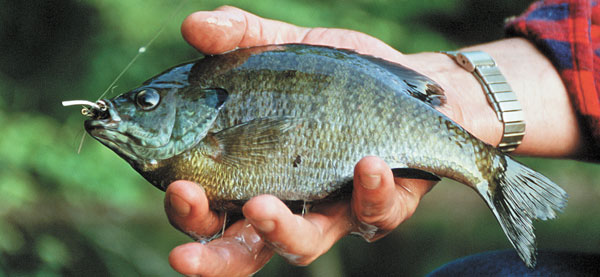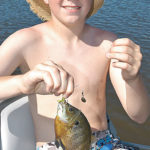
I am a tournament bass fisherman by trade, and I love an occasional vacation from those green fish. For someone who has travelled back and forth across the country dozens of times over the past 15 years fishing for bass, a vacation to me is staying home — and fishing for bream.
I do love bream-fishing; I enjoy catching bluegills as much as any other fish, because ounce-for-ounce, they might be the strongest freshwater fish we’ve got — stronger than a smallmouth bass in New York or a spotted bass in Alabama.
I fished for bluegills a lot as a kid; it’s something that all fishermen do at some time. I’ve never lost my love for catching them, and I do enjoy eating them, whether they’re from Lake Murray or the pond on my property or they’re bream that Kevin Van Dam caught through the ice in Michigan — we fry them up a lot when we’re out fishing tournaments.
One thing I truly love is instead of fishing for five bites a day like I do when I’m fishing a bass tournament, when I get out and fish for bluegills, I get to fish for numbers of fish, for 20 or 30 a day. And I get to do it with my sons and my wife and make it a family thing. For me, it’s a totally different fishing mentality — more enjoyable and relaxing.
I start looking for bream to start spawning in May, and then in June and July, especially. In good habitat, with plenty for them to eat, bluegill will spawn multiple times in the same summer. I’m looking for congregations of fish, those big beds with all the dish-shaped depressions that are anywhere from six to 16 inches across. There may be from 10 to 100 in a spot, when you find them.
I had my best day ever bream-fishing back in May; I took my oldest son Parker to a place in Laurel Hill, N.C., called the Kingfisher Society. I’ve filmed a couple of TV shows up there with O’Neill Williams, and they have some of the best lakes I’ve ever fished. If they’re not as good as Ray Scott’s lakes in Alabama, they’re sure close.
A lot of people, when they tell you they caught a 1-pound bream, in reality, it probably weighed 12 ounces. Before I took Parker up there, the biggest bream I’d ever caught weighed a pound and five ounces. Fishing with him, I caught a 1-8 and a 1-12, and he caught three that weighed 1-12. My biggest fish came on a fly-rod, and it took me a long time to land that fish.
Anyway, what I usually start out doing when I’m bream fishing is look for beds. That’s hard to do if you’re just sitting in one place fishing on the bottom. Being a bass fisherman, I do love to chunk-and-wind, so I’ll take a little 4-foot ultralight Pfleuger spinning outfit I’ve got, spooled with 4-pound test line, and tie on something like a Beetle Spin or a Mepps spinner. My favorite colors are black and yellow, because I think they show up good, but I can also remember when I was a kid seeing my dad pull larvae out of a wasp’s nest to fish for bream with, and those are about the same colors.
I’ll get my polarized sunglasses on and work down the bank of a lake, looking for a bream bed. Usually, they’ll be on a place that’s got a little harder bottom, either shells or rocks or at least sand. When I find them with a Beetle Spin, I’m going to stop, dig out a cricket and put him on the hook, settle down and catch a bunch of ’em. When I’m targeting bluegills, I’m going to use crickets, because they’re feeding on larvae and insects. If I’m targeting shellcrackers, which are more of a bottom-feeder than bluegills, I’ll use red worms.
It’s also really fun to catch them on a fly-rod. They’ll hit a wet or a dry fly, and just like I love to catch bass on a topwater bait, I love to catch bluegill on a fly. You know, fly-fishing nowadays comes across as something from out west or in the mountains — not a southern thing — but really, in the South, we’ve been fishing for bream with fly rods for years. I can remember my granddaddy fishing for bream with a fly-rod. And you can never tell; you might get tied up by a 5½-pound largemouth when you’re using a fly rod — I did that up in North Carolina the same day we caught all the bream. That was by far the biggest bass of my life on a fly-rod.
So take some time out this month and put down that worm rod or crankbait rod and pick up an ultralight or a fly rod or a cane pole and stop and enjoy the kind of fishing . you can have when you’ve got a pond full of bream.






Be the first to comment